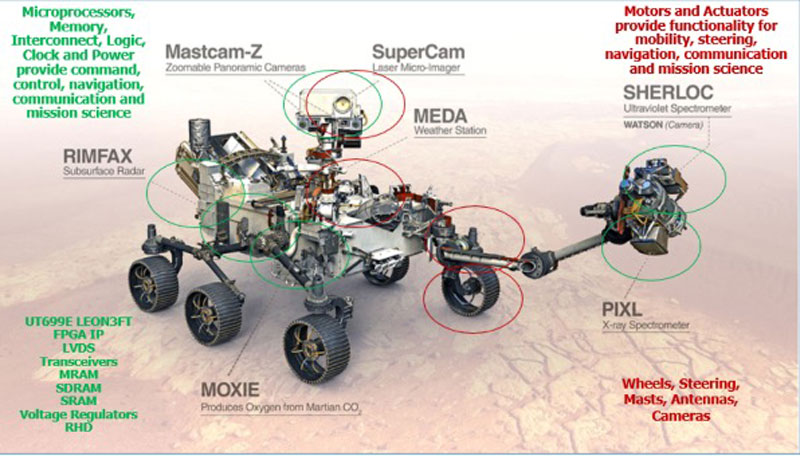Frontgarde-ing the Red Planet
Last month, the world celebrated with NASA as the MARS2020 Perseverance Rover completed its nearly six-month and 300-million-mile journey to reach the Red Planet. CAES is infinitely proud of our contributions to this historic mission to search the surface of Mars for signs of microbial life and gain a better understanding of the planet’s geology.
The following outlines how some of CAES’ radiation hardened microelectronics and motion control products are supporting the mission.
- The Mastcam-Z, an advanced camera system with panoramic and stereoscopic imaging capability with the ability to zoom, has the CAES UT54LVDS218 Deserializer in the camera interface. Check out some of these pictures here.
- The Planetary Instrument for X-ray Lithochemistry (PIXL) is an X-ray fluorescence spectrometer containing an imager with high resolution to determine the fine-scale elemental composition of Martian surface materials. It includes CAES LEON3 UT699 microprocessor, MRAM, SDRAM, LVDS, 16-bit Interface, MSI Logic devices, as well as RHD5910, VRG 8662, VRG8663 and VRG8669.
- Mars Oxygen ISRU Experiment (MOXIE), an exploration technology investigation that will produce oxygen from Martian atmospheric carbon dioxide, has CAES Analog Multiplexers, MRAM and VRG8662/63, as well as UT63M143.
- Scanning Habitable Environments with Raman & Luminescence for Organics and Chemicals (SHERLOC), a spectrometer that will provide fine-scale imaging and uses an ultraviolet (UV) laser to determine fine-scale mineralogy and detect organic compounds, incorporates the UT699E, UT54LVDS032LV, as well as CAES SRAM and MSI Logic.
- CAES’ electromechanical actuators are performing some of the most critical mobility, navigation, communications and science functions aboard the spacecraft, specifically:
- WSA-2 Wheel Actuators for all six wheels
- WSA-2 Steering Actuators for outer four wheels
- HGA Azimuth and Elevation Actuators for High Gain Antenna Gimbal
- RSM And RSMD High Torque Actuators to Deploy the Navigation and Science Mast and to provide Azimuth/Elevation Mobility to the Mast Head Containing Science and Navigation Instruments
- A Suite of 16 Miniature (10mm Diameter), Cryogenic Capable Actuators to Operate Various Functionalities within the Mast Head Assembly.
Here is the graphical representation of where CAES’ parts are supporting the MARS2020 Perseverance Rover.

Figure 1: Image courtesy of NASA (Instruments - NASA Mars).
Over the next few years, the rover will continue to explore the Jezero Crater region of Mars and collect samples that NASA hopes will be able to return to the U.S. In the meantime, CAES will continue to follow the MARS2020 mission and remain tightly coupled with NASA to ensure optimal operation of our products on this mission.
